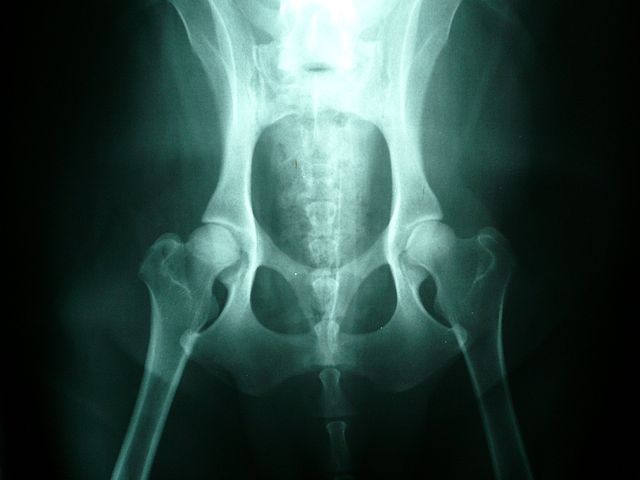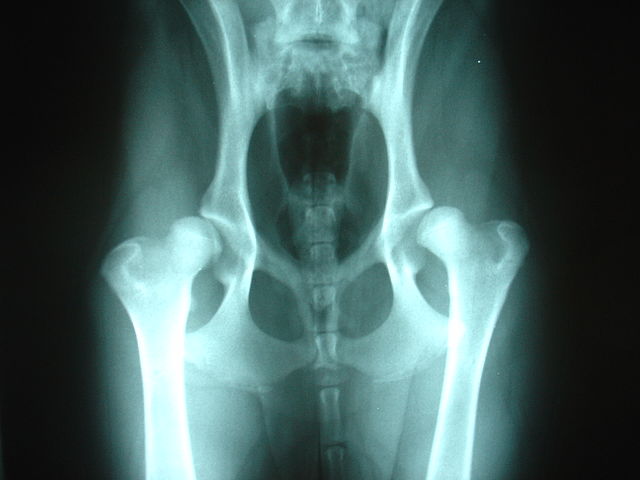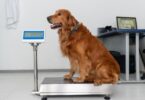Hip Dysplasia in Dogs
The hip joint consists of a “ball” on the femoral bone, and a “socket” on the hip bone. Hip dysplasia in dogs, also known as Canine hip dysplasia (CHD), is when a dog’s hips do not develop normally and the ball does not fit snugly into the socket. This condition creates undue stress on the joint.
Joint instability develops, causing damage to the cartilage, gradual destruction of the joint, pain and swelling. CHD most often causes arthritis in the hips.
NORMAL CANINE HIP JOINTS

Normal Canine Hips, Joel Mills, Licensed under Creative Commons Attribution-Share Alike 3.0-2.5-2.0-1.0
BILATERAL CANINE HIP DYSPLASIA
What Causes Hip Dysplasia in Dogs?
There are two theories about causes hip dysplasia in dogs:
- Genetic: the dog is born with it. This is the most popular theory. The disease is passed on by the parents, resulting in the puppies carrying the genes for CHD. Not all dogs with the gene show signs of the disease.
- Environmental: the puppy is too heavy, not exercised enough, or exercised too much during its initial growth period resulting in developmental problems.
What are the Symptoms of Canine Hip Dysplasia?
- walking with a limp
- difficulty getting up from a sitting position
- hops like a bunny when running
- reluctant to climb stairs
- a swaying gait
- pain in the hip
- has less energy and movement
However, these symptoms are usually not evident till the dog reaches middle age. In extreme cases though, some dogs exhibit obvious hip problems as early as 5-6 months of age. The only way to find out if your dog definitely has hip dysplasia is to get x-rayed by a vet.
How is Canine Hip Dysplasia Diagnosed?
Diagnosis of the hip dysplasia in dogs is done with x-rays, which can tell you how bad the condition is, and what treatment is needed. X-rays taken again at a later date can also gauge the progression of the disease in order to adjust treatment, if necessary.
What is the Treatment for Canine Hip Dysplasia?
There are two options for treatment: non-surgical management or surgery. Non-surgical methods may include the use of drugs to relieve pain and inflammation, supplements, acupuncture, physical therapy, chiropractic care, exercise, and weight management.
If non-surgical management is not enough, surgery may be needed, although most people see this as a last resort. Surgery can be very effective as it corrects the underlying cause of hip pain which is a malformed joint. There are two different ways of doing the surgery. One is prophylactic surgery done to prevent the progression of arthritis. The other is therapeutic surgery which aims to treat already arthritic hips.
You will need to talk to your Vet about what options are best for your dog. They will be able to give you recommendations for treatment and will be able to give you the details of the surgery if needed. There are several surgeries available but it is beyond the scope of this article to go into detail here.
Can Canine Hip Dysplasia be Prevented?
Don’t overfeed your dog, especially during the growing phase. Excessive weight, or rapid weight gain, creates more stress on the joints, causing problems. If your dog has the CHD genes, this can slow down the process considerably.
Don’t over-exercise your dog. Don’t let it jump up and down from heights.
Since hip dysplasia in dogs is genetic, it is important to prevent further breeding of the line. Breed stock may have the gene for CHD and not show any signs. If your dog has canine hip dysplasia, she should not be bred.
If you are buying a dog, look for a reputable breeder. If one parent dog has hip dysplasia, the risk of it occurring in the litter is doubled. Good breeders take care to prevent this situation from occurring. The pedigrees of dogs can be checked to see whether they have been certified as normal by the Orthopedic Foundation For Animals (OFA) in the US.
Other organizations that check for markers of hip normalcy in dogs are PennHip and the GDC (Genetic Disease Control in Animals). Large breed dogs have a greater chance of developing hip dysplasia, and prospective owners would be wise to take this precaution.
Does your dog suffer from hip dysplasia? Do you have any advice?








